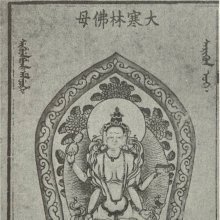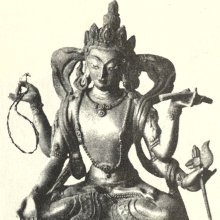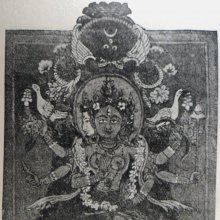Sitavati, Sitavatī, Shitavati: 5 definitions
Introduction:
Sitavati means something in Buddhism, Pali, Hinduism, Sanskrit. If you want to know the exact meaning, history, etymology or English translation of this term then check out the descriptions on this page. Add your comment or reference to a book if you want to contribute to this summary article.
Images (photo gallery)
In Hinduism
Shaivism (Shaiva philosophy)
Source: Wisdom Library: ŚaivismSitavatī (सितवती) refers to the city of Varuṇa, situated on the western lower slope of mount Meru, according to Parākhyatantra 5.66. Meru is the name of a golden mountained situated in the middle of nine landmasses (navakhaṇḍa): Bhārata, Hari, Kimpuruṣa, Ramyaka, Ramaṇa, Kuru, Bhadrāśva, Ketumāla and Ilāvṛta. Together these khaṇḍas make up the continent known as Jambūdvīpa.
Sitavatī is also known by the name Sita or Śuddhavatī and is mentioned in various other sources, eg., the Svacchanda-tantra 10.132-136, Kiraṇa-āgama 8.51-54, Mṛgendra-āgama vidyāpāda 13.47-54, Sarvajñānottara-tantra adhvaprakaraṇa 34-36 and Mataṅga-āgama vidyāpāda 23.60-63
The Parākhyatantra is an old Śaiva-siddhānta tantra dating from before the 10th century.

Shaiva (शैव, śaiva) or Shaivism (śaivism) represents a tradition of Hinduism worshiping Shiva as the supreme being. Closely related to Shaktism, Shaiva literature includes a range of scriptures, including Tantras, while the root of this tradition may be traced back to the ancient Vedas.
In Buddhism
Tibetan Buddhism (Vajrayana or tantric Buddhism)
Source: archive.org: The Indian Buddhist IconographyŚītavatī (शीतवती) is another name for Mahāśītavatī: one of the five Protector Goddesses (Rakṣa or Pañcarakṣa), commonly depicted in Buddhist Iconography, and mentioned in the 11th-century Niṣpannayogāvalī of Mahāpaṇḍita Abhayākara.—Her Colour is red; her Symbol is the lotus; she has three faces and eight arms.— The fourth deity in the series of five Rakṣā goddesses is named as Mahāśītavatī to whom the western direction is assigned. She is widely represented in Buddhist countries. Under the title of Śītavatī she is known to the Chinese collection.

Tibetan Buddhism includes schools such as Nyingma, Kadampa, Kagyu and Gelug. Their primary canon of literature is divided in two broad categories: The Kangyur, which consists of Buddha’s words, and the Tengyur, which includes commentaries from various sources. Esotericism and tantra techniques (vajrayāna) are collected indepently.
Languages of India and abroad
Sanskrit dictionary
Source: Cologne Digital Sanskrit Dictionaries: Edgerton Buddhist Hybrid Sanskrit DictionaryŚītavatī (शीतवती).—name of a rakṣā (q.v.): Dharmasaṃgraha 5 (no v.l.). See Mahāsitavatī, which is the form always printed in Sādhanamālā; but some of its mss. several times are reported as reading °śīta°.
--- OR ---
Sitavatī (सितवती).—see Mahā-si° and Śītavatī.
Source: Cologne Digital Sanskrit Dictionaries: Monier-Williams Sanskrit-English DictionaryŚītavatī (शीतवती):—[=śīta-vatī] [from śīta] f. See mahā-ś.
[Sanskrit to German]
Sanskrit, also spelled संस्कृतम् (saṃskṛtam), is an ancient language of India commonly seen as the grandmother of the Indo-European language family (even English!). Closely allied with Prakrit and Pali, Sanskrit is more exhaustive in both grammar and terms and has the most extensive collection of literature in the world, greatly surpassing its sister-languages Greek and Latin.
See also (Relevant definitions)
Ends with: Asitavati, Mahashitavati.
Full-text: Mahashitavati, Mahashetavati, Raksha, Maharaksha, Pancaraksha, Sita, Shuddhavati, Meru.
Relevant text
Search found 1 books and stories containing Sitavati, Sitavatī, Shitavati, Śītavatī, Shita-vati, Śīta-vatī, Sita-vati; (plurals include: Sitavatis, Sitavatīs, Shitavatis, Śītavatīs, vatis, vatīs). You can also click to the full overview containing English textual excerpts. Below are direct links for the most relevant articles:
The Indian Buddhist Iconography (by Benoytosh Bhattachacharyya)
Related products


